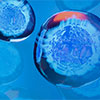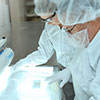Mass+Spectrometry
Catalog Number:
(10431-940)
Supplier:
Bioss
Description:
The KRAS gene encodes the human cellular homolog of a transforming gene isolated from the Kirsten rat sarcoma virus. The RAS proteins are GDP/GTP-binding proteins that act as intracellular signal transducers. The most well-studied members of the RAS (derived from 'RAt Sarcoma' virus) gene family include KRAS, HRAS, and NRAS. These genes encode immunologically related proteins with a molecular mass of 21 kD and are homologs of rodent sarcoma virus genes that have transforming abilities. While these wildtype cellular proteins in humans play a vital role in normal tissue signaling, including proliferation, differentiation, and senescence, mutated genes are potent oncogenes that play a role in many human cancers.
Catalog Number:
(10097-272)
Supplier:
Proteintech
Description:
Endofin (also known as ZFYVE16) is an endosomal FYVE domian protein implicated in regulating membrane trafficking. Endofin has been shown to localize to early endosomes. It co-localizes with SARA but does not associate with it or Smad2 and does not behave like SARA in affecting TGF-signaling. Northern blot analysis showed ZFYVE16 was widely expressed with high levels in kidney, placenta and lung. Overexpression of Endofin causes endosome aggregation. The gene of ZFYVE16 maps to chromosome 5q14, and encodes a 1539-amino acid protein with a molecular mass of 169 kDa. In addition, endogenous Endofin can also be detected as a band of 230-250 kDa.
Catalog Number:
(10095-546)
Supplier:
Proteintech
Description:
The synaptotagmins are integral membrane proteins of synaptic vesicles thought to serve as Ca(2+) sensors in the process of vesicular trafficking and exocytosis . SYT1 (synaptotagmin I) was firstly identified as a 65-kDa protein with a wide distribution in neuronal and neurosecretory tissue . Calcium binding to SYT1 participates in triggering neurotransmitter release at the synapse . In addition to regulating exocytosis, SYT1 has also been implicated in endocytosis and neurite outgrowth . This antibody recognizes endogenous SYT1, which has an experimentally determined molecular mass of 65-68 kDa. An additional band of 47 kDa could also be detected, which is corresponding to the calculated molecular weight of SYT1.
Catalog Number:
(76118-730)
Supplier:
Bioss
Description:
DRAK1 (DAP kinase-related apoptosis-inducing protein kinase 1) is a novel member of the ser/thr protein kinase family, which mediate apoptosis through their catalytic activities. The full-length cDNA encodes a deduced 414-amino acid protein with a molecular mass of 46.56 kD. DRAKs contain an N-terminal kinase domain and a C-terminal regulation domain. DRAK1 messenger RNA appears to be ubiquitously expressed in human tissues. Overexpression of DRAK1 induces apoptosis. It has been shown <i>in vitro</i> that DRAK1 is capable of autophosphorylation and of phosphorylating the myosin light chain as an exogenous substrate, and that the noncatalytic C terminus is crucial for full kinase activity.
Catalog Number:
(10085-876)
Supplier:
Proteintech
Description:
DKK1, also named a SK and Dickkopf-1, belongs to the dickkopf family. DKKs play an important role in vertebrate development, where they locally inhibit Wnt regulated processes such as antero-posterior axial patterning, limb development, somitogenesis and eye formation. In the adult, Dkks are implicated in bone formation and bone disease, cancer and Alzheimer disease. SDS-PAGE and Western blot analysis demonstrated that DKK1 is expressed as a 35-kD doublet protein, which is larger than the deduced molecular mass of 26 kD. Sometime DKK1 is expressed as a 42- to 50-kD secreted protein, with little change observed after glycanase treatment.
Catalog Number:
(10094-650)
Supplier:
Proteintech
Description:
SIGMAR1, also named as OPRS1, SRBP, SIG-1R and AAG8, belongs to the ERG2 family. It is an endoplasmic reticulum chaperone that binds a wide variety of ligands, including neurosteroids, psychostimulants, and dextrobenzomorphans. SIGMAR1 is ubiquitously expressed, and is enriched in motor neurons of the brain and spinal cord. It plays a role in calcium signaling through modulation together with ANK2 of the ITP3R-dependent calcium efflux at the endoplasmic reticulum. SIGMAR1 plays a role in several other cell functions including proliferation, survival and death. SDS-PAGE and Western blot analysis showed that SIGMAR1 has an apparent molecular mass of 28 kDa. SIGMAR1 has 5 isoforms with MW 21-27kDa and 12kDa.
Catalog Number:
(CAPIPA5-18738)
Supplier:
Thermo Scientific
Description:
The p70/p80 autoantigen is a nuclear complex consisting of two subunits with molecular masses of approximately 70 and 80 kDa. The complex functions as a single-stranded DNA-dependent ATP-dependent helicase. The complex may be involved in the repair of nonhomologous DNA ends such as that required for double-strand break repair, transposition, and VJ recombination. High levels of autoantibodies to p70 and p80 have been found in some patients with systemic lupus erythematosus.
Catalog Number:
(10454-142)
Supplier:
Bioss
Description:
DRAK1 (DAP kinase-related apoptosis-inducing protein kinase 1) is a novel member of the ser/thr protein kinase family, which mediate apoptosis through their catalytic activities. The full-length cDNA encodes a deduced 414-amino acid protein with a molecular mass of 46.56 kD. DRAKs contain an N-terminal kinase domain and a C-terminal regulation domain. DRAK1 messenger RNA appears to be ubiquitously expressed in human tissues. Overexpression of DRAK1 induces apoptosis. It has been shown in vitro that DRAK1 is capable of autophosphorylation and of phosphorylating the myosin light chain as an exogenous substrate, and that the noncatalytic C terminus is crucial for full kinase activity.
Catalog Number:
(10085-958)
Supplier:
Proteintech
Description:
FKBP2 is also named as FKBP13 and belongs to the FKBP-type PPIase family. It catalyzes the cis-trans isomerization of proline imidic peptide bonds in oligopeptides. FKBP2 has a 21-amino acid signal peptide and appears to be membrane-associated. It is localized to the lumen of the endoplasmic reticulum (ER). FKBP12 and FKBP13 are highly similar proteins, of molecular masses 12 kDa and 13 kDa respectively, with approx.43 % amino acid identity. The strong homology between FKBP12 and FKBP13 suggests that they may share similar biological functions, although, apart from rotamase activity, details relating to the function of either protein are scant.
Catalog Number:
(10454-352)
Supplier:
Bioss
Description:
DRAK1 (DAP kinase-related apoptosis-inducing protein kinase 1) is a novel member of the ser/thr protein kinase family, which mediate apoptosis through their catalytic activities. The full-length cDNA encodes a deduced 414-amino acid protein with a molecular mass of 46.56 kD. DRAKs contain an N-terminal kinase domain and a C-terminal regulation domain. DRAK1 messenger RNA appears to be ubiquitously expressed in human tissues. Overexpression of DRAK1 induces apoptosis. It has been shown in vitro that DRAK1 is capable of autophosphorylation and of phosphorylating the myosin light chain as an exogenous substrate, and that the noncatalytic C terminus is crucial for full kinase activity.
Supplier:
Ace Glass
Description:
An efficient protruded metal dump-packing for distillation columns of 1" to 12" diameter
Supplier:
Trajan Scientific and Medical
Description:
This wide range of fully deactivated inlet liners is compatibile with the industry's most popular instrument makes and models.
Catalog Number:
(10084-624)
Supplier:
Proteintech
Description:
CSK(Tyrosine-protein kinase CSK) is also named as C-Src kinase, protein-tyrosine kinase CYL and belongs to the protein kinase superfamily. Csk is a non-receptor tyrosine kinase with a molecular mass of 50 kDa. It contains the SH3 and SH2 domains in its N-terminus and a kinase domain in its C-terminus. It negatively regulates the kinase activity of SFKs and plays an important role in physiological functions via signaling pathways for cell proliferation, differentiation, adhesion, and migration. Csk may play a role in tumor suppression by inhibiting the oncogenic activity of SFKs. Indeed, overexpression of Csk can inhibit tumor growth of human colon cancer cells. This protein can be autophosphorylated.
Catalog Number:
(RL012-001-B32)
Supplier:
Rockland Immunochemical
Description:
Rat IL- 17A (IL-17), also known as CTLA-8, is a proinflammatory cytokine member of a six-species family of proteins (IL-17A-17F). Rat IL-17A protein is a homodimer consisting of two 134 amino acids peptides. IL-17A is secreted mainly by activated CD4+ and CD8+ T lymphocytes and acts through its receptor, IL-17R, to induce the expression of many mediators of inflammation, most strikingly, those that are involved in the proliferation, maturation and chemotaxis of neutrophils. Elevated levels of IL-17A have been associated with several conditions, including rheumatoid arthritis, airway inflammation, allograft rejection, inflammatory bowel disease, psoriasis, cancer and multiple sclerosis. There is 58% identity between the amino acid sequence of human and rat IL-17A. Recombinant rat IL-17A produced in E.coli is a non-glycosylated disulfide-joined homodimer having a molecular mass of 30.0 kDa.
Catalog Number:
(10336-042)
Supplier:
Bioss
Description:
This gene encodes a transmembrane protein containing six epidermal growth factor repeats. The protein is involved in the differentiation of several cell types, including adipocytes; it is also thought to be a tumor suppressor. It is one of several imprinted genes located in a region of on chr 14q32. Certain mutations in this imprinted region can cause phenotypes similar to maternal and paternal uniparental disomy of chromosome 14 (UPD14). This gene is expressed from the paternal allele. A polymorphism within this gene has been associated with child and adolescent obesity. The mode of inheritance for this polymorphism is polar overdominance; this non-Mendelian inheritance pattern was first described in sheep with the callipyge phenotype, which is characterized by muscle hypertrophy and decreased fat mass. [provided by RefSeq, Mar 2010].
Catalog Number:
(CAPIPA5-18685)
Supplier:
Thermo Scientific
Description:
This antibody is predicted to react with canine based on sequence homology. Members of the BTB/POZ family of transcriptional regulators, including BTBD14B, contain a conserved motif in the N-terminal region critical for protein-protein interactions and assembly of high molecular mass complexes .
Inquire for Price
Stock for this item is limited, but may be available in a warehouse close to you. Please make sure that you are logged in to the site so that available stock can be displayed. If the
Stock for this item is limited, but may be available in a warehouse close to you. Please make sure that you are logged in to the site so that available stock can be displayed. If the
You must log in to order restricted items. We request that you provide the required business documentation to purchase this product for the first time.
To order chemicals, medical devices, or other restricted products please provide identification that includes your business name and shipping address via email CMD_NA@vwr.com or fax 484.881.5997 referencing your VWR account number . Acceptable forms of identification are:
-Additional Documentation May be needed to purchase this item. A VWR representative will contact you if needed.
This product has been blocked by your organization. Please contact your purchasing department for more information.
The original product is no longer available. The replacement shown is available.
This product is currently unavailable but limited stock may be available in our extended warehouse network. Please call 1-800-932-5000 and a VWR Customer Service Representative will help you.
|
|||||||||


































